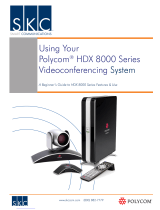
Contents
System Basics ...................................................................................... 1
Using the Remote Control ..................................................................................................... 1
Getting More Information...................................................................................................... 3
Calling and Answering.......................................................................... 4
Answering a Video Call ......................................................................................................... 4
Placing a Video Call .............................................................................................................. 4
Ending a Video Call .............................................................................................................. 6
Types of Video Calls You Can Make......................................................................................... 7
Placing Audio-only Calls and Adding Audio-Only Sites (VSX 8000) ............................................... 8
Ending an Audio-Only Call ..................................................................................................... 9
Controlling What You See................................................................... 10
Selecting and Adjusting a Camera or Other Video Source..........................................................10
Setting and Using Camera Presets .........................................................................................12
Switching Between Full Screen Video and the Home Screen ......................................................13
Showing, Moving, and Turning Off the PIP ..............................................................................14
Enabling Voice Tracking to Presets (VSX 8000 Only) ................................................................15
Controlling What You Hear ................................................................. 16
Adjusting Volume................................................................................................................16
Muting the Microphone ........................................................................................................16
Enjoying Stereo Audio in Video Calls ......................................................................................17
Showing Content and Video Sources .................................................. 18
What You See When You Show Content..................................................................................18
Showing Content from a Laptop or PC....................................................................................18
Using a Document Camera, VCR, or DVD Player ......................................................................20
Working with Directory Entries .......................................................... 21
Searching the Directory .......................................................................................................21
Adding, Editing, and Deleting Directory Entries........................................................................21
Categorizing Directory Entries...............................................................................................23
Including Multiple Sites in Calls ......................................................... 24
About Multipoint Calls ..........................................................................................................24
Placing a Multipoint Call .......................................................................................................24
Supplying a Password for External MCU Calls ..........................................................................25
Setting the Multipoint Viewing Mode ......................................................................................26
Controlling How the System Answers Multipoint Calls ...............................................................27
Using Chair Control for Multipoint Calls...................................................................................27
© POLYCOM, INC. iii




















